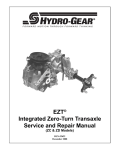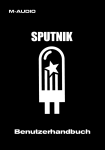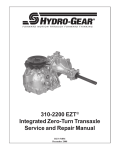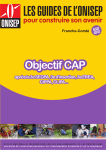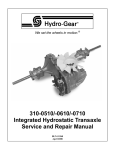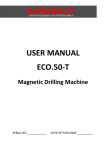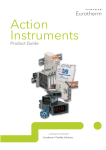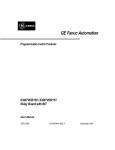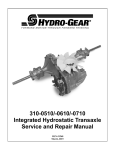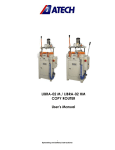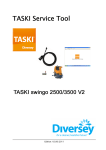Download ZT-2800 Service Manual
Transcript
ZT-2800® Integrated Zero-Turn Transaxle Service and Repair Manual BLN-52441 December 2008 Table Of Contents Foreword ...................................................... 1 Hub Removal ............................................... 19 Description and Operation ............................ 2 Tear Down and Reassembly........................ 20 Introduction ................................................... 2 How To Use This Manual ............................. 20 Hydraulic Schematic ..................................... 3 General Instructions .................................... 20 External Features ......................................... 4 Tools ............................................................ 21 Technical Specifications ............................... 6 Torques ........................................................ 21 Product Identification .................................... 6 Transaxle Removal ...................................... 22 Safety ........................................................... 7 Fan and Pulley........................................ 22-24 Personal Safety ............................................ 7 Side Cover .................................................. 25 Tool Safety .................................................... 7 Bull, Pinion and Reduction Gears................ 26 Work Area Safety.......................................... 7 Charge Pump .............................................. 27 Servicing Safety............................................ 7 Input Shaft ................................................... 28 Troubleshooting ............................................ 8 Bypass Arm ................................................. 29 Service and Maintenance ............................. 9 Swashplate .................................................. 30 External Maintenance ................................... 9 Center Section ............................................. 31 Service and Maintenance Procedures.......... 9 Brake Assembly ...................................... 32-33 Fluids ............................................................ 9 Center Section Kit........................................ 34 Fluid Volume and Level ................................ 9 Check Plugs & Seals ................................... 35 Filter and Filter Guard................................. 10 Cylinder Blocks ............................................ 35 Fluid Change Procedure............................. 11 Axle Shaft .................................................... 36 Purging Procedures .................................... 12 Assembly After Complete Tear Down .......... 37 Return To Neutral Setting ........................... 13 Side Cover – Screw Tightening Sequence .. 38 Return To Neutral Assembly ....................... 14 How To Use Service Schematic .................. 39 Control Arm Assembly ................................ 15 ZT-2800® Transaxle Exploded View ............ 40 Parking Brake Adjustment .......................... 16 ZT-2800® Transaxle Parts List ..................... 41 Parking Brake Assembly............................. 17 Glossary Of Terms .................................. 42-43 Brake Arm Assembly .................................. 18 ZT-2800® i FOREWORD Headquartered in Sullivan, Illinois, Hydro-Gear® is a world leader in the design, manufacture, and service of quality hydrostatic transaxles for the lawn and garden industry. The mission of our company is to be recognized by our customers and the industry as a world-class supplier and the quality leader in everything we do. Internal repair procedures require that the transaxle unit be removed from the vehicle. This Service and Repair Manual is designed to provide information useful in servicing and troubleshooting the Hydro-Gear ZT-2800 ® Integrated Zero-Turn Transaxle. This is not a certification, test or study guide for a certification test. If a technician is interested in certification, they should contact an agent representing EETC (Equipment & Engine Training Council) at (262) 367-6700 or their Hydro-Gear Central Service Distributor. Many distributors will be hosting certification testing. These study guides will cover most of the products and manufacturers in our industry. Also included is a glossary of terms that are frequently used throughout the industry and in Hydro-Gear service publications. Understanding terminology is very important! For more information about Hydro-Gear or our products, please contact your Central Service Distributor, or call our Customer Service Department at (217) 728-2581. It is necessary, and a good shop practice, that your service area be equipped with the proper tools and the mechanics be supplied the latest information available. All repair procedures illustrated in this guide are suggested, but preferred methods of repair. ZT-2800® 1 DESCRIPTION AND OPERATION Introduction The purpose of this manual is to provide information useful in servicing the Hydro-Gear® ZT-2800 ® Integrated Zero-Turn Transaxle. This manual includes the ZT-2800’s general descriptions, hydraulic schematics, technical specifications, servicing and troubleshooting procedures. Other than recommended oil and filter changes, the transaxle normally will not require servicing during the life of the vehicle in which it is installed. Should other servicing be required, the exterior of the transaxle will need to be thoroughly cleaned before beginning most procedures. Do not wash the transaxle while it is hot. Do not use a pressure washer to clean the unit. General Description The ZT-2800 is a self contained unit designed for the transfer and control of power. It provides an infinitely variable speed range between zero and maximum in both forward and reverse modes of operation. This transaxle uses a variable displacement pump with a maximum displacement of 10cc per revolution, and motor with a fixed displacement of 16cc per revolution. The variable displacement pump features a trunnion mounted swashplate with a direct-proportional displacement control. Reversing the direction of the swashplate reverses the flow of oil from the pump and thus reverses the direction of the motor output rotation. The pump and motor are of the axial piston design and utilize spherical nosed pistons which are held against a thrust race by internal compression springs. The ZT-2800 transaxle is fully flooded with oil. A common external expansion tank assures the drives’ cool, quiet operation. An external filter provides ease of access for oil maintenance of the drive for the estate and entry level profes2 sional vehicles. The ZT-2800 is designed for both charged and uncharged product versions. In the uncharged consumer vehicle drive, fluid passes through the filter by interaction of the positive head on the fluid from a properly elevated expansion tank and the negative pressure created at the pump inlet during piston operation. Hydro-Gear’s patented charge configuration is used in the estate/professional version. Here, fluid is drawn from the case and through the filter and into a fixed displacement gerotor pump. Charge pump flow not used to feed the low pressure side of the system is passed over a charge relief valve and back into the transaxle case. The check valves in the center section are used to control the make-up flow of the fluid to the low pressure side of the loop. The ZT-2800 has an internal cog style parking brake. It is essential to fully disengage the brake prior to operation. A cam style, block lifting bypass is utilized in the ZT-2800 to permit moving the vehicle for a short distance at a maximum of 2 m.p.h. (3.2 Km/h) without starting the engine. The brake must be disengaged prior to actuating the bypass mechanism. WARNING Actuating the bypass will result in the loss of hydrostatic braking capacity. The machine must be stationary on a level surface and in neutral when actuating the bypass. ZT-2800® HYDRAULIC SCHEMATIC Vent Input Shaft Case Reservoir Bypass Motor Pump Motor Shaft System Check Valves Filter Charge Relief Charge Pump Figure 1, Hydraulic Schematic With Charge Pump Vent Input Shaft Case Reservoir Bypass Pump Motor Motor Shaft System Check Valves Filter Figure 2, Hydraulic Schematic Without Charge Pump ZT-2800® 3 EXTERNAL FEATURES ZT-2800® Axle Shaft Parking Brake Shaft Main Housing Bypass Arm Control Arm — Top View — Drain Port (For Horizontal Installation) Top Port Plug Parking Brake Arm Side Cover — Inboard View — 4 ZT-2800® EXTERNAL FEATURES ZT-2800® Input Shaft Axle Shaft Oil Filter Expansion Port (For Horizontal Installation) — Outboard View—Left (Standard Control) — Fan and Pulley Kit Return To Neutral Assembly Charge Pump — Outboard View—Right (Return To Neutral Control) — ZT-2800® 5 TECHNICAL SPECIFICATIONS ZT-2800 ® TECHNICAL SPECIFICATIONS Overall Transaxle Reduction 20.69:1 24.74:1 27.23:1 Input Speeds 3000 rpm Non-Charge — 3600 rpm Charged Maximum Hi-Idle (No Load) 1800 rpm Minimum Output Torque Intermittent 300 lb-ft (406 N-m) 340 lb-ft (461 N-m) 370 lb-ft (502 N-m) Continuous 160 lb-ft (217 N-m) 180 lb-ft (244 N-m) 200 lb-ft (270 N-m) Maximum with 18” tires 400 lb (181 kg) 480 lb (217 kg) 540 lb (244 kg) Maximum with 20” tires 360 lb (163 kg) 440 lb (199 kg) 480 lb (217 kg) Maximum with 22” tires — 400 lb (181 kg) 440 lb (199 kg) Weight on Tires (per unit) Axle Shaft Diameter 1.00 in (25.4 mm) Axle Shaft End Options Tapered 4–Bolt Flange Parking Brake Type Internal 32 lb (14.5 kg) Weight of Unit PRODUCT IDENTIFICATION The model and configuration of the ZT-2800 can be determined from the label shown below. HYDRO-GEAR BOM Mo del Num ber ilt u Year B ZH-KCEE-1B8C-1BXX 5 186 B4 476 Date (Julian- Day of year) ZH-KCEE-1B8C-1BXX ing Number Sales Draw Assembled in USA Serial Number (unique for that model - for that day) Type of Product and Build Information Figure 3, Configuration Label 6 ZT-2800® SAFETY This symbol points out important safety instructions which, if not followed, could endanger the personal safety and/or property of yourself and others. Read and follow all instructions in this manual before attempting maintenance on your transaxle. When you see this symbol - HEED ITS WARNING. Wear appropriate clothing. Loose or hanging clothing or jewelry can be hazardous. Use the appropriate safety equipment, such as eye and hearing protection, and safety-toe and slip-proof shoes. Never use compressed air to clean debris from yourself or your clothing. Tool Safety WARNING POTENTIAL FOR SERIOUS INJURY Inattention to proper safety, operation, or maintenance procedures could result in personal injury, or damage to the equipment. Before servicing or repairing the ZT-2800® transaxle, fully read and understand the safety precautions described in this section. Personal Safety Certain safety precautions must be observed while servicing or repairing the ZT-2800. This section addresses some of these precautions but must not be considered an all-inclusive source on safety information. This section is to be used in conjunction with all other safety material which may apply, such as: 1. Other manuals pertaining to this machine, 2. Local and shop safety rules and codes, 3. Governmental safety laws and regulations. Use the proper tools and equipment for the task. Inspect each tool before use and replace any tool that may be damaged or defective. Work Area Safety Keep the work area neat and orderly. Be sure it is well lit, that extra tools are put away, trash and refuse are in the proper containers, and dirt or debris have been removed from the working areas of the machine. The floor should be clean and dry, and all extension cords or similar trip hazards should be removed. Servicing Safety Certain procedures may require the vehicle to be disabled in order to prevent possible injury to the servicing technician and/or bystanders. The loss of hydrostatic drive line power may result in the loss of hydrostatic braking capability. Be sure that you know and understand the equipment and the hazards associated with it. Do not place speed above safety. Some cleaning solvents are flammable. Use only approved cleaning materials: Do not use explosive or flammable liquids to clean the equipment. Notify your supervisor whenever you feel there is any hazard involving the equipment or the performance of your job. To avoid possible fire, do not use cleaning solvents in an area where a source of ignition may be present. Never allow untrained or unauthorized personnel to service or repair the equipment. Discard used cleaning material in the appropriate containers. ZT-2800® 7 TROUBLESHOOTING WARNING Do not attempt any servicing or adjustments with the engine running. Use extreme caution while inspecting the drive belt assembly and all vehicle linkage! Follow all safety procedures outlined in the vehicle owner’s manual. In many cases, problems with the ZT-2800® are not related to a defective transaxle, but are caused by slipping drive belts, partially engaged bypass valves, and loose or damaged control linkages. Be sure to perform all operational checks and adjustments outlined in Service and Maintenance, before assuming the transaxle is malfunctioning. The table below provides a troubleshooting checklist to help determine the cause of operational problems. T RO U BLE S HOOT I NG CHE CKL I S T Po s s ible Cau s e Co r r e c t ive Ac t io n U nit Op er at e s I n On e Dir e c t io n On l y Control linkage bent or out of adjustment Repair or replace linkage, Page 9 Drive belt slipping or pulley damaged Repair or replace drive belt or pulley, Page 9 Ve hicle Doe s No t Dr ive /Tr a ck S t r a ig h t Vehicle tires improperly inflated Refer to vehicle manufacturer suggested pressure Control linkage bent or out of adjustment Repair or replace linkage, Pages 9 and 13 Bypass assembly sticking Repair or replace bypass, Page 29 Brake Partially Engaged Disengage Brake, Replace Broken or Missing Brake Return Spring Un it I s No isy Oil level low or contaminated oil Fill to proper level or change oil, Page 11 Excessive loading Reduce vehicle loading, Page 9 Loose parts Repair or replace loose parts Bypass assembly sticking Repair or replace linkage, Page 9 Air trapped in hydraulic system Purge hydraulic system, Page 12 Brake Partially Engaged Disengage Brake, Replace Broken or Missing Brake Return Spring Un it Ha s No /L ow Powe r Engine speed low Adjust to correct setting Control linkage bent or out of adjustment Repair or replace linkage, Page 9 Drive belt slipping or pulley damaged Repair or replace drive belt or pulley, Page 9 Oil level low or contaminated oil Fill to proper level or change oil, Page 11 Excessive loading Reduce vehicle loading, Page 9 Bypass assembly sticking Repair or replace linkage, Page 9 Air trapped in hydraulic system Purge hydraulic system, Page 12 Brake Partially Engaged Disengage Brake, Replace Broken or Missing Brake Return Spring Un it I s Op e r at in g Ho t Debris buildup around transaxle Clean off debris, Page 20 Cooling fan damaged Repair or replace cooling fan, Pages 22-24 Oil level low or contaminated oil Fill to proper level or change oil, Page 11 Excessive loading Reduce vehicle loading, Page 9 Air trapped in hydraulic system Purge hydraulic system, Page 12 Brake Partially Engaged Disengage Brake, Replace Broken or Missing Brake Return Spring Tr a n sa x le L e a k s Oil 8 Damaged seals, housing, or gaskets Replace damaged components Air trapped in hydraulic system Purge hydraulic system, Page 12 ZT-2800® SERVICE AND MAINTENANCE External Maintenance Regular external maintenance of the ZT-2800® should include the following: 1. Check the vehicle operator’s manual for the recommended load ratings. Insure that the current application does not exceed load rating. 2. Check oil level in accordance with “Fluid Change Procedure,” step 12. Refer to page 11. 3. Inspect the vehicle drive belt, idler pulley(s), and idler spring(s). Insure that no belt slippage can occur. Slippage can cause low input speed to the transaxle. 4. Inspect the vehicle control linkage to the directional control arm on the transaxle. Also insure that the control arm is securely fastened to the trunnion arm of the transaxle. 5. Inspect the bypass mechanism on the transaxle and the vehicle linkage to insure that both actuate and release fully. Service and Maintenance Procedures Some of the service procedures presented on the following pages can be performed while the ZT-2800 is mounted on the vehicle. Any repair procedures as mentioned in the repair section of this manual must be performed after the unit has been removed from the vehicle. Typically, an engine oil with a minimum rating of 9.0 cSt (55 SUS) at 230° F (110° C) and an API classification of SL is recommended. A 20W50 engine oil has been selected for use by the factory and is recommended for normal operating procedures. Fluid Volume and Level Fluid volume information is provided in the table below. Total system volume will depend on expansion tank size, hose length and transaxle volume. Certain situations may require additional fluid to be added or even replaced. Refer to page 10 and figure 5 for the proper fill port location. Recheck the fluid level once the unit has been operated for approximately 1 minute. Purging will be required if oil has been changed. Refer to the purging procedures on page 12. Fluid Description 20W50 engine oil Component Volume Transaxle (bottom of fill port) 2284 ml (77.23 fl. oz.) Expansion Tank (cold fill line) 40-82 ml (1.35-2.77 fl. oz.) Hose (0.5″ I.D.) 38.60 ml (1.31 fl. oz.) / ft. Fluids The fluids used in Hydro-Gear products have been carefully selected, and only equivalent, or better products should be substituted. ZT-2800® 9 FILTER AND FILTER GUARD Refer to Figure 4 Disassembly Assembly 1. Remove the hex head screws (105), and filter guard (106). 1. Reassemble all parts in the reverse order of disassembly. 2. Remove the filter (23) and discard. 2. When tightening the fasteners, refer to the table on page 21 for the required torque values. NOTE: Always replace the filter when performing any internal maintenance to the transaxle. 3. Remove the metal oil drain plug (5) or the fitting (111) from inlet port and allow any remaining oil to drain from the transaxle. Inspection 3. Fill transaxle with oil. Refer to “Fluid Change Procedures,” page 11, steps 3 and 4 for filter change instructions. NOTE: As a general rule, use the low end of the torque specification on fasteners when reassembling the unit. 1. Inspect all parts for excessive wear or damage. Replace if necessary. 111 Units will have installed, the fitting (111) or the plug (5). 23 5 Drain port (for horizontal installation) 11 106 When refilling the transaxle with oil, remove the port plug (5), if installed, and plug (11). Fill until the oil reaches the lower lip of port (11) on side cover. 105 Figure 4, Filter and Guard 10 ZT-2800® FLUID CHANGE PROCEDURE This transaxle is designed with an external filter for ease of maintenance. To ensure constant fluid quality levels and longer life, an initial oil and filter change at 75-100 hours, then every 400 hours thereafter is recommended. The following procedure can be performed with the transaxles installed in the vehicle, and the vehicle on level ground. Apply the bypass valve for each transaxle and lock the vehicle parking brake. 1. Remove the three 1/4” filter guard screws and filter guard. Clean any loose debris from around the perimeter of the filter. See figures 4 and 5. 2. Place an oil drain pan (12” or more diameter and 8 qt. capacity is optimal) beneath the oil filter. Remove the oil filter from the transaxle. 3. After the oil has drained, wipe the filter base surface off and apply a film of new oil to the gasket of the new replacement filter (HydroGear part number 52114). 4. Install the new filter by hand, turn 3/4 to one full turn after the filter gasket contacts the filter base surface. 5. Re-install the filter guard with three 1/4” screws. Torque screws to 65 in. lbs. (7.3 Nm) each. 6. Repeat steps 1-5 on the opposite side transaxle drive. 7. Drain old oil filters of all free flowing oil prior to disposal. Place used oil in appropriate containers and deliver to an approved recycling collection facility. 8. Remove the top port plug (figure 6) from the left side and right side transaxles prior to filling with oil. This will allow the transaxles to vent during oil fill. 9. Remove the cap from the transaxle’s expansion tank located on the vehicle frame. 10. Fill with 20W50 motor oil until oil just appears at the bottom of each transaxle’s top port (approximately 2 qts. per transaxle, 4 qts. total). Install the top port plug into each transaxle as the oil level reaches this port. 11. Install and torque the top port plugs to 180 in. lbs. (20.3 Nm). 12. Continue to fill the transaxles through the expansion tank until the “Full Cold” line is reached on the Hydro-Gear expansion tank (refer to vehicle owner’s manual for specific volumes). 13. Re-install the expansion tank cap by hand. Be careful to not overtighten. 14. Proceed to the purge procedure. Top Port Plug Filter Filter Guard Filter (Guard Removed For Visual Clarity) Figure 5, Filter Location ZT-2800® Screws Figure 6, Filter And Filter Guard 11 PURGING PROCEDURES Due to the effects air has on efficiency in hydrostatic drive applications, it is critical that it is purged from the system. Air creates inefficiency because its compression and expansion rate is higher than that of the oil approved for use in hydrostatic drive systems. The following procedures are best performed with the vehicle drive wheels off the ground. Then repeated under normal operating conditions. If this is not possible, then the procedure should be performed in an open area free of any objects or bystanders. 1. Disengage the brake if activated. These purge procedures should be implemented any time a hydrostatic system has been opened to facilitate maintenance or the oil has been changed. 2. With the bypass valve open and the engine running, slowly move the directional control in both forward and reverse directions (5 or 6 times). The resulting symptoms in hydrostatic systems may be: 3. With the bypass valve closed and the engine running, slowly move the directional control in both forward and reverse directions (5 to 6 times). Check the oil level, and add oil as required after stopping the engine. 1. Noisy operation. 2. Lack of power or drive after short term operation. 3. High operation temperature and excessive expansion of oil. Before starting, make sure the transaxle is at the proper oil level. If it is not, fill to the specifications outlined in this manual. 12 4. It may be necessary to repeat Steps 2 and 3 until all the air is completely purged from the system. When the transaxle operates at normal noise levels and moves smoothly forward and reverse at normal speeds, then the transaxle is considered purged. ZT-2800® RETURN TO NEUTRAL SETTING WARNING WARNING POTENTIAL FOR SERIOUS INJURY Do not attempt any servicing or adjustments with the engine running. Use extreme caution while inspecting the drive belt assembly and all vehicle linkage! Inattention to proper safety, operation, or maintenance procedures could result in personal injury, or damage to the equipment. Before servicing or repairing the ZT-2800® transaxle, fully read and understand the safety precautions described in this section. Follow all safety procedures outlined in the vehicle owner’s manual. The return to neutral mechanism on the transaxle is designed to set the directional control into a neutral position when the operator releases the vehicle hand control. Follow the procedures below to properly adjust the return to neutral mechanism on the transaxle: 3. Start the engine and increase the throttle to full engine speed. 1. Confirm the transaxle is in the operating mode (bypass disengaged). Raise the vehicle’s drive tires off the ground to allow free rotation. 5. Stop the vehicle’s engine. Reattach and adjust the vehicle’s linkage according to the vehicle owner’s manual. NOTE: It may be necessary to remove the drive tire from the axle hub to access the linkage control and the transaxle return arm. Remove the wheel by removing the lug nuts. Do not remove the axle/hub nut. 2. Remove the Original Equipment Manufacturer’s (OEM’s) control linkage at the control arm. ROTATION "B" 4. Check for axle rotation. If the axle does not rotate, go to Step 5. If the axle rotates, go to Step 6. 6. Note the axle directional movement. Stop the vehicle engine. Loosen the RTN adjustment screw until the control arm can be rotated. Rotate the control arm in the opposite direction of the axle rotation in 5 degree increments. Tighten the RTN adjustment screw. Recheck according to steps 3 and 4. Refer to Figure 7. ROTATION "A" RTN Adjusting Screw Speed and Direction Control Arm Figure 7, Return to Neutral Setting ZT-2800® 13 RETURN TO NEUTRAL ASSEMBLY Refer to Figure 8 Disassembly Assembly 1. Remove all items previously discussed in their recommended order. 1. Reassemble all parts in the reverse order of disassembly. 2. Remove the RTN control arm kit (211) by first removing the spring (147) and Torx head screw (46). The remaining members of the assembly can be removed as a single item – washer (146), unidirectional scissor arm kit (145), and the control arm (44). 2. When tightening the fasteners, refer to the table on page 21 for the required torque values. 3. Refer to the RTN adjustments on page 13. NOTE: As a general rule, use the low end of the torque specification on fasteners when reassembling the unit. 3. Remove the Allen head screw (142), washer (45), neutral arm (141) and spacer (140). NOTE: Only remove the seal (41) if damaged or worn. The seal is not part of the RTN control arm kit (211), and cannot be serviced separately. Refer to “Seal Kit” in the Items List on page 41. Inspection 46 1. Inspect all parts for excessive wear or damage. Replace if necessary. 146 211 145 44 142 45 141 140 147 41 REFER TO “RETURN TO NEUTRAL SETTING” ON PAGE 13. Figure 8, Return to Neutral Assembly 14 ZT-2800® CONTROL ARM ASSEMBLY Refer to Figure 9 Disassembly Assembly 1. Remove all items previously discussed in their recommended order. 1. Reassemble all parts in the reverse order of disassembly. 2. Remove the lock nut (47), the washer (45) and the Torx head screw (46). 2. When tightening the fasteners, refer to the table on page 20 for the required torque values. 3. Remove the control arm (44), the washers (43) and the stud (42). NOTE: Only remove the seal (41) if damaged or worn. The seal cannot be serviced separately. Refer to “Seal Kit” in the Items List on page 41. NOTE: As a general rule, use the low end of the torque spec on fasteners when reassembling the unit. Inspection 1. Inspect all parts for excessive wear or damage. Replace if necessary. 44 45 47 43 42 46 41 Figure 9, Control Arm Assembly ZT-2800® 15 PARKING BRAKE ADJUSTMENT (Code 1 or 2) Character #7 in the model number code = 1 or 2. Example: ZX-XXXX-1XXX-XXXX 4. While holding the parking brake handle (102) firmly onto the splines, remove clip (103) from the shaft tip. 5. Before removing the parking brake handle (102) scribe a reference mark between the handle and shaft tip (101). WARNING POTENTIAL FOR SERIOUS INJURY When servicing the parking brake on unlevel terrain, it is essential to chock the vehicle wheels to prevent vehicle movement. It should not be necessary to adjust the transaxle parking brake over the life of the vehicle. In the event that the transaxle parking brake does not hold per vehicle manufacturer’s specifications, the parking brake can be adjusted by rotating the handle (102). 1. Note orientation of the vehicle parking brake and linkage in the activated (locked) position. 2. Disengage the brake. 3. Detach the vehicle parking brake linkage from the parking brake handle (102). 6. Remove the brake handle (102) far enough to rotate the handle one tooth in the angular direction opposite the brake handle’s actuated position. 7. Attach the retaining clip (103) to the brake cam shaft. 8. Connect the vehicle parking brake linkage to the brake handle (102). 9. Test the parking brake to assure it meets the vehicle manufacturer’s specifications. 10. It is also important to assure that the parking brake is not partially engaged while the vehicle is in the normal drive mode. This can be confirmed by moving the vehicle to level ground, turning the engine off, disengaging the brake, engaging the bypass and assuring that the vehicle can be moved by pushing with reasonable effort. Brake (Cam) Shaft (101) Brake Handle (102) Reference Mark Clip (103) Brake (Cam) Shaft (101) Figure 10, Brake Handle Orientation 16 Brake Handle (102) Figure 11, Brake Handle Removal ZT-2800® PARKING BRAKE ASSEMBLY (Code 1 or 2) Character #7 in the model number code = 1 or 2. Inspection Example: ZX-XXXX-1XXX-XXXX 1. Inspect all parts for excessive wear or damage. Replace if necessary. Refer to Figure 12 2. Inspect the splines on the handle and brake cam shaft. Disassembly 1. Mark the position of the cam stop retainer (104) in relation to the side cover (2). NOTE: The orientation of the cam stop and brake-cam to one another is very important. Indicate their relationship to each other on the side cover to assist in their correct assembly. See Insert below. 2. Remove the retaining clip (103). Assembly 1. Reassemble all parts in the reverse order of disassembly. 2. When tightening the fasteners, refer to the table on page 21 for the required torque values. NOTE: As a general rule, use the low end of the torque specification on fasteners when reassembling the unit. 3. Mark the position of the brake (cam) shaft (101) in relation to the brake handle (102). 4. Remove the brake handle (102). 5. Remove the hex head screws (105) and the cam stop retainer (104). Brake-Cam Shaft (101) Cam Stop Retainer (104) ORIENTATION Cam Stop Retainer (104) 105 102 Side Cover (2) 103 Brake (Cam) Shaft (101) Figure 12, Parking Brake ZT-2800® 17 BRAKE ARM ASSEMBLY (Code 3) Character #7 in the model number code = 3 Inspection Example: ZX-XXXX-3XXX-XXXX 1. Inspect all parts for excessive wear or damage. Replace if necessary. Refer to Figure 13 Disassembly 2. Inspect the splines on the brake arm and brake shaft. 1. Mark the position of the brake arm (102) in relation to the brake shaft (101). Assembly NOTE: The orientation of the brake arm and brake shaft to one another is very important. 1. Reassemble all parts in the reverse order of disassembly. 2. Remove the retaining clip (103). 3. Remove the brake arm (102). Brake Arm (102) Reference Mark Brake Shaft (101) Brake Shaft (101) 102 103 Figure 13, Parking Brake 18 ZT-2800® HUB REMOVAL Do not use this procedure to remove the drive wheel from the transaxle. Remove the drive wheel by removing the lug nuts. 5. Tighten the 1-1/8” socket head center bolt evenly and slowly. Note: This pressure will separate the hub from the tapered axle. DESCRIPTION: Follow the directions below for removal of 4 bolt flanged hubs from tapered axle shafts to facilitate maintenance to bearings, bushings and seals externally. 6. Remove the lug nuts and separate the hub removal tool from the flanged hub and discard the “old” flanged hub and replace with a new flanged hub. WARNING 7. Refer to the appropriate manual / schematics for parts, repair procedures and proper torque during reassembly of the flanged hub to the tapered axle. POTENTIAL FOR SERIOUS INJURY Inattention to proper safety, operation, or maintenance procedures could result in personal injury, or damage to the equipment. Before servicing or repairing the transaxle, fully read and understand the safety precautions described in the transaxle Service and Repair manual that pertains to the specific transaxle to be repaired. 8. Install wheel and rim and torque lug nuts. Reference applicable vehicle service manual for proper lug nut torque. 9. Lower the vehicle to the ground, remove chocks. Note: Brake will still be in engaged mode. Hub Retaining Nut Flanged Hub Note: Before using the Hub Removal Tool (Hydro - Gear P/N 71241), apply a thin coat of anti-seize to the bolt threads. Thread the bolt in and out of the Hub Puller prior to using it for the first time. 1. With the vehicle engine placed in the “OFF” position, chock the front wheels, engage the parking brake. Raise the vehicle drive tires off the ground and remove the lug nuts from the vehicles’ drive wheel/hub studs. Axle Shaft (94) Lug Nut Figure 14, Hub Assembly 2. Remove the hex retaining nut (3/4-16) from the center of the axle hub. 3. Back out the hub removal tool bolt with a 1-1/8” socket before installing the hub removal tool to the axle hub. 4. Insert the hub removal tool over the flange wheel hub studs. Install lug nuts and secure evenly. Torque to 100 lb-in. (11.3 Nm). ZT-2800® 19 TEAR DOWN AND REASSEMBLY How to Use This Manual Each subassembly illustrated in this manual is illustrated with an exploded view showing the parts involved. The item reference numbers in each illustration are for assembly instructions only. See page 41 for part names and descriptions. A complete exploded view and item list of the transaxle is provided at the end of the repair section. General Instructions Cleanliness is a primary means of assuring satisfactory life on repaired units. Thoroughly clean all exposed surfaces prior to any type of maintenance. Cleaning of all parts by using a solvent wash and air drying is usually adequate. As with any precision equipment, all parts must be kept free of foreign material and chemicals. Upon removal, it is recommended that all seals, O-rings, and gaskets be replaced. During installation lightly lubricate all seals, O-rings and gaskets with a clean petroleum jelly prior to assembly. Also protect the inner diameter of seals during installation by covering the shaft with a cellophane or plastic wrap material. Be sure all remnants of this covering are removed after servicing. Parts requiring replacement must be replaced from the appropriate kits identified in the Items Listing, found at the end of this manual. Use only original Hydro-Gear replacement parts found in BLN-51427 (CD). IMPORTANT: When internal repair is performed on the ZT-2800® transaxle, the oil filter must be replaced. Protect all exposed sealing surfaces and open cavities from damage and foreign material. The external surfaces should be cleaned before beginning any repairs. Do not use a pressure washer to clean the transaxle. 20 ZT-2800® TOOLS R E QUIRED TOOL S Miscellaneous Hub Puller Flat Blade Screw Driver (2) Torque Wrench Air Impact Wrench Rubber or Neoprene Mallet Breaker Bar Side Cutters/Snips Needle Nose Pliers Large External Snap Ring Pliers Small Internal Snap Ring Pliers Sockets 1/2”-3/8” Adapter 3/8” Deep 1-1/8” Deep 1/4” Allen 3/4” Deep 9/16” Deep T-40 Torx Head 7/8” Deep TORQUES R E Q U I R ED TORQUE VAL UES Item Description Torque Operation 5 7 11 23 24 25 27 42 46 47 99 105 111 122 123 134 142 142 Plug 9/16-18 (Metal) Screw, Hex head 1/4-20 x 1.25” Plug, 9/16-18 (Metal) Filter Check Plug or Shock Valve Check Plug or Shock Valve Screw, Hex Head 3/8-16 x1.5 Stud, Short 5/16-24 Torx Head Screw 5/16-24 x 1.00 Nut, Hex Lock 5/16-24 UNF Nut, Hex Lock 3/4-16 Screw, Hex Head 1/4-20 x .75 Fitting, STR 9/16-18 SAE Nut, Hex Locking 1/2-20 Nylon Screw, Hex Head HFHCS 1/4-20 x .75 SHCS 5/16-24 x 1 Patch Stud, 5/16-24 Friction Pack 180 – 240 lb-in (20.3 - 27.1 Nm) 105 – 155 lb-in (11.8 - 17.5 Nm) 180 – 240 lb-in (20.3 - 27.1 Nm) 130 – 150 lb-in (14.7 - 16.9 Nm) 280 – 400 lb-in (31.6 - 45.2 Nm) 280 – 400 lb-in (31.6 - 45.2 Nm) 525 – 700 lb-in (59.3 - 79.1 Nm) 50 – 120 lb-in (5.6 - 13.5 Nm) 230 – 310 lb-in (25.9 - 35.0 Nm) 85 – 120 lb-in (9.6 - 13.5 Nm) 180 – 200 lb-ft (244 - 271 Nm) 65 – 95 lb-in (7.3 - 10.7 Nm) 180 – 240 lb-in (20.3 - 27.1 Nm) 360 – 520 lb-in (40.6 - 58.7 Nm) 50 – 80 lb-in (5.6 - 9.0 Nm) 65 – 95 lb-in (7.3 - 10.7 Nm) 175 – 200 lb-in (19.7 - 22.6 Nm) 50 – 65 lb-in (5.6 - 7.3 Nm) Oil Input Port Side Cover Screws Side Cover, Oil Level Port Oil Filter Center Section Center Section Center Section Screws Control Arm RTN/FR Control Arm Control Arm, Short Stud Hub Nut Filter Guard Screws Breather Fitting Fan to Input Shaft Nut Fan to Pulley Assembly Charge Plate Screws Neutral Arm Screw Friction Pack Stud As a general rule, use the low end of the torque spec on fasteners when reassembling the unit. ZT-2800® 21 TRANSAXLE REMOVAL FAN AND PULLEY NOTE: It is necessary to remove the ZT-2800® from the vehicle before performing the repair procedures presented in this section. To remove the wheel from the hub, do so by removing the lug nuts. Do not remove the axle/hub nut unless replacing the hub, the axle seal or removing the axle shaft. Refer to Figure 15 Before starting any disassembly, make certain that your work area is neat and clean. Clean the external parts of the transaxle. The following procedures are presented in the order recommended for a complete tear down of the transaxle. Do not disassemble the unit any farther than necessary to accomplish the required repairs. Reassembly is accomplished by performing the “Assembly” portions of the procedures. If the unit has been completely disassembled, a summary of the assembly procedures, in the order in which they should occur, is given on page 37. 122 123 Disassembly FAN AND PULLEY KIT (207) CONFIGURATION “A” 1. Remove the locknut (122), slotted washer (123), fan (120) and the pulley (121) from the input shaft. Inspection 1. Check all components for excessive wear or damage. Replace if necessary. 2. Inspect input shaft splines for wear or damage. Assembly 1. Reassemble all parts in the reverse order of disassembly. 2. When tightening the fasteners, refer to the table on page 21 for the required torque values. NOTE: As a general rule, use the low end of the torque specification on fasteners when reassembling the unit. 120 121 Figure 15, Fan/Pulley Kit (207) Configuration “A” 22 ZT-2800® FAN AND PULLEY (Continued) Refer to Figure 16 Refer to Figure 17 FAN AND PULLEY KIT (207) CONFIGURATION “B” FAN AND PULLEY KIT (207) CONFIGURATION “C” 1. Remove the locknut (122), and detach the fan and pulley assembly from the input shaft. 1. Remove the locknut (122) and detach the fan and pulley assembly from the input shaft. 2. Separate the assembly by removing the screws (123), fan (120) and the pulley (121). 2. Remove the hex head screws (123) to separate the fan (120) and pulley (121) assembly. Inspection Inspection 1. Check all components for excessive wear or damage. Replace if necessary. 1. Check all components for excessive wear or damage. Replace if necessary. Assembly Assembly 1. Reassemble all parts in the reverse order of disassembly. 1. Reassemble all parts in the reverse order of disassembly. 2. When tightening the fasteners, refer to the table on page 21 for the required torque values. 2. When tightening the fasteners, refer to the table on page 21 for the required torque values. NOTE: As a general rule, use the low end of the torque specification on fasteners when reassembling the unit. 122 122 123 121 120 120 121 123 Figure 16, Fan/Pulley Kit (207) Configuration “B” Figure 17, Fan/Pulley Kit (207) Configuration “C” ZT-2800® 23 FAN AND PULLEY (Continued) Refer to Figure 18 Disassembly FAN AND PULLEY KIT (207) CONFIGURATION “D” 1. Remove the locknut (122), slotted washer (123), pulley (121), fan (120) and pulley disc (121) the from the input shaft. Inspection 1. Check all components for excessive wear or damage. Replace if necessary. 2. Inspect input shaft splines for wear or damage. Assembly 1. Reassemble all parts in the reverse order of disassembly. 2. When tightening the fasteners, refer to the table on page 21 for the required torque values. NOTE: As a general rule, use the low end of the torque specification on fasteners when reassembling the unit. 122 123 124 120 121 Figure 18, Fan/Pulley Kit (207) Configuration “D” 24 ZT-2800® SIDE COVER Refer to Figure 19 Disassembly Inspection 1. Remove all external items previously discussed in their recommended order. 1. Inspect the bearing and bushing areas in the side cover for excessive wear or damage. Replace if necessary. 2. Remove filter (23) and discard. Drain oil from transaxle. Refer to page 11. Assembly 3. Remove the screws (7), separate side cover (2) from main housing (1), using “pry points” as required. 1. Apply a bead of sealant around the perimeter of the main housing face. See “Sealant Application Diagram” on page 37. 4. Remove the bearing (93) from side cover (2). 2. Install the locating pins, if not already installed. 5. Remove the spacer (92) from axle (94). 3. Install the side housing (2). Use care not to smear the sealant bead. 6. Clean off all the old sealant from the cover (2) and the main housing (1). Take care not to damage the sealing surfaces. A wire brush and solvent is effective. IMPORTANT: Before scraping the old sealant from the main housing, place a protective cover over the internal parts of the transaxle; avoiding any debris from entering the housing. 4. Install the side housing screws (7). Refer to the screw tightening pattern on page 38. 5. When tightening the fasteners, refer to the table on page 21 for the required torque values. 1 94 Pry Point Locating pin 2 92 93 Pry Point 7 Locating pin Stuff a clean rag in the center section oil filter passage before scraping the sealant off the center section. This is to prevent any sealant from getting into the oil passage. Figure 19, Side Cover ZT-2800® 25 BULL, PINION AND REDUCTION GEARS Refer to Figure 20 Disassembly Assembly 1. Remove external items beginning on page 22. 1. Install the washer (74), pinion gear (72), and secure their placement with retaining ring (71) onto the motor shaft (73). 2. Remove washer (80) and reduction gear set (81-82) as an assembly and set aside. Remove second washer (80) and jack shaft pin (83). 3. Remove the washer (70), retaining ring (71), pinion gear (72) and washer (74) from the motor shaft (73). 4. Remove the bull gear (91). 2. Install the washer (70) onto the motor shaft (73). 3. Install the bull gear (91) onto the axle (94). 4. Install the jack shaft pin (83), washer (80), reduction gears (82) and (81). 5. Install washer (80) to jack shaft pin (83). Inspection 1. Inspect the bull gear (91) – teeth and internal splines, for wear or damage. 2. Separate the reduction gears and inspect the gears and jack shaft pin for excessive wear or damage. Replace if necessary. 94 91 80 83 81 82 80 74 70 71 72 Motor Shaft (73) Figure 20, Bull, Reduction and Pinion Gear 26 ZT-2800® CHARGE PUMP Refer to Figures 21-21a Disassembly 1. Mark the orientation of the charge pump cover relative to the main housing, prior to removal. Refer to figure 21. 2. Remove the hex head screws (134), charge pump cover, gerotor assembly, and the Oring (132). Remove the connecting tubes (130) at this point – only if the center section will be removed. A pick type tool can be used to remove the connection tubes. 3. When tightening the fasteners, refer to the table on page 21 for the required torque values. NOTE: As a general rule, use the low end of the torque specification on fasteners when reassembling the unit. Inspection 1. Inspect the gerotor assembly for wear or damage. Replace if necessary. Assembly 1. Reassemble all parts in the reverse order of disassembly. NOTE: When reinstalling the charge pump components, replace the O-ring (132) Also replace the connecting tubes (130), if they have been removed. 130 132 2. Align the mark on the charge pump cover, from step 1, Disassembly, with the mark on the main housing. Gerotor Charge Pump Cover 203 Charge Pump Cover Main Housing 134 Figure 21a, Charge Pump Mark Figure 21, Charge Pump Cover Orientation ZT-2800® 27 INPUT SHAFT Refer to Figure 22 Disassembly Assembly 1. Requires removal of all items beginning on page 22. 1. Reassemble all parts in the reverse order of disassembly. 2. Remove the retaining ring (57). 3. Remove the lip seal (56) and discard. 4. Remove the washer (55) and the pump shaft assembly (52–53). NOTE: To assist in the removal of the pump shaft, lightly tap (using a neoprene head hammer) the shaft from the charge pump side of housing. Care should be taken not to damage the shaft or gerotor running surface. 57 56 55 54 53 52 Remove the bearing from pump shaft only if worn or damaged. 5. Remove the wire ring retainer (54) and the bearing (53) from the pump shaft (52). Inspection 1. Inspect the bearing and input shaft for wear or damage. Inspect the splines on the shaft for possible damage. Replace if necessary. Figure 22, Input Shaft 28 ZT-2800® BYPASS ARM Refer to Figure 23 Disassembly Assembly 1. Requires removal of all items beginning on page 22. 1. Install a new lip seal (30). 2. Remove the push-on retaining ring (35) and discard. Remove the bypass arm (34). 3. Remove the retaining ring (33). 4. Remove the bypass rod (32) and the clip retaining ring (31) as a single item. 2. Install the clip retaining ring (31) and bypass rod (32). 3. Install the retaining ring (33). 4. Install the bypass arm (34) and new push-on retaining ring (35). NOTE: It is not necessary to remove the clip retaining ring (31) from the bypass rod (32) unless it is damaged or worn. 5. Remove the lip seal (30) and discard. 35 Inspection 1. Inspect the bypass rod (32) for wear or damage. Replace if necessary. NOTE: Take care to insure that the bypass rod is free of burrs that may cut the rubber lip seal. 34 33 32 31 30 Figure 23, Bypass Arm ZT-2800® 29 SWASHPLATE Refer to Figures 24-25 Disassembly Assembly 1. Requires removal of all items beginning on page 22. 1. Reassemble all parts in the reverse order of disassembly. 2. Remove the swashplate (40) and pump cylinder block assembly (69) as a single item. 2. Apply a light coating of oil to running surfaces on center section, swashplate bearing races, thrust bearing assembly and pump block assembly. 3. Separate the pump cylinder block assembly (69) and the thrust bearing (65) from the swashplate (40) and set aside. NOTE: Removal will be aided by applying a small amount of pressure on the trunnion mounted swashplate towards the center section. While CAREFULLY removing the swashplate and block assembly, keep the block face flush with the center section to minimize damage to the running surface. 3. Place the thrust bearing assembly (65) into swashplate (40) such that the thick race of the bearing assembly faces out. 4. With the piston facing the thrust bearing, place the pump block assembly (69) into the swashplate. 5. While pressing the pump block assembly (thrust bearing – pump cylinder block) and swashplate together, align to center section in main housing. Inspection 1. Inspect the swashplate (40) and thrust bearing assembly (65) for wear or damage. Replace if necessary. 2. Inspect pump block per detail on page 32. 40 65 Thick Race Toward Pistons 69 Figure 25, Hydraulic Pump Components 40 69 Figure 24, Swash Plate 30 ZT-2800® CENTER SECTION Refer to Figure 26 Disassembly Assembly 1. Requires removal of all items beginning on page 22. 1. Reassemble all parts in the reverse order of disassembly. 2. Remove the center section mounting screws (27). 2. Apply a light coating of oil to all running surfaces on the center section. 3. Remove the center section, the motor shaft (73), the motor cylinder block assembly (64) and the brake shaft (101) as a single item. 3. Place the thrust bearing assembly (60) into the main housing (1). 4. Remove the motor cylinder thrust bearing (60). 5. Remove the motor cylinder block assembly (64) from the motor shaft (73). Remove the motor shaft (73) from the center section. NOTE: A bypass puck is located beneath the motor cylinder block assembly. See item 22, page 34. 6. Remove brake shaft assembly (101) and set aside. Refer to figures 27-28, pages 32-33. Inspection 1. Inspect the races of the thrust bearing (60) for wear or damage. 4. Place the motor shaft (73) into the center section. Slide the motor block assembly (64) onto the motor shaft (73) so that the pistons are facing the thrust bearing (60). 5. Install the brake shaft assembly (101), if not already installed. Refer to figures 27-28, pages 32-33. 6. Align the assembled components (center section, the motor block and shaft, and the brake shaft assembly) with the main housing and install. 7. Install the center section mounting screws (27) to the proper torque. 1 2. Inspect the motor shaft for wear or damage. Replace if necessary. 3. Inspect for scratches on the machined surfaces of the center section. 4. Inspect motor cylinder block assembly (64) per detail on page 35. 64 73 27 60 27 101 Center Section 27 Figure 26, Center Section ZT-2800® 31 BRAKE ASSEMBLY (Code 1 or 2) Character #7 in the model number code = 1 or 2. Assembly Example: ZX-XXXX-1XXX-XXXX 1. Install the new O-rings (10) onto the brake (cam) shaft (101). Refer to Figure 27 NOTE: Apply a thin coating of oil to the O-rings before installing. Disassembly 1. Remove the center section per detail on page 31. NOTE: Take note of the orientation of the brake cam (101) and the brake puck (100). 2. Remove the brake (cam) shaft (101) and the brake puck (100). To protect the O-rings from possible damage during installation, apply a protective covering over the splines of the brake cam (e.g., cellophane, tape, etc.). 2. Place the brake puck (100) onto the brake (cam) shaft (101). Install the brake cam kit (208) in center section. 3. Remove the O-rings (10) from the brake (cam) shaft (101) and discard. Inspection 1. Inspect all components for unusual wear or damage. Center Section 100 10 101 10 Figure 27, Brake Cam Kit 32 ZT-2800® BRAKE ASSEMBLY (Code 3) Assembly Character #7 in the model number code = 3 1. If removed, install brake pawl on brake shaft. Refer to figure 29 for orientation Example: ZX-XXXX-3XXX-XXXX NOTE: Apply a thin coating of oil to the O-rings before installing. Refer to Figure 28 Disassembly 1. Remove the center section per detail on page 31. NOTE: Take note of the orientation of the brake pawl (100) and the brake shaft (101). 2. Remove the brake shaft (101) and the brake pawl (100). To protect the O-rings from possible damage during installation, apply a protective covering over the splines of the brake shaft (e.g., cellophane, tape, etc.). 2. Install the new O-rings (10) onto the brake shaft (101). 3. Remove the O-rings (10) from the brake shaft (101) and discard the O-rings. 4. Remove the brake pawl from the brake shaft if pawl, shaft or splines are damaged. Inspection Z * - (G, H, J) * * * - * (A-D, J-M) * * - * * * * 1. Inspect all components for unusual wear or damage. Center Section Z * - (K, L, M) * * * * - * (A-D, J-M) * * - * * * * 101 10 Z * - (G, H, J) * * * - * (E-H, N-T) * * - * * * * 100 10 Figure 28, Brake Shaft Assembly ZT-2800® Z * - (K, L, M) * * * - * (E-H, N-T) * * - * * * * Figure 29, Brake Pawl Orientation 33 CENTER SECTION KIT Refer to Figure 30 Disassembly Assembly 1. Remove the bypass plate (22) from the center section. 1. Install the charge relief kit (202). Beginning with the ball, then the spring, followed by, the cross pin. 2. Remove the plug seals (26) and discard. Refer to figure 31, on page 35. IMPORTANT: Before removing the check plugs, it is important to note their specific location, i.e., check plug (24) needs to be reinstalled in the same port it was removed from and the same for check plug (25). After removing the check plugs, inspect for debris or damage. 3. Remove the check plugs (24) and (25) and inspect. Refer to Check Plugs & Seals, page 35. 2. Install the new check plugs (24) and (25) in their proper ports. 3. Install the new plug seals (26). 4. Install the bypass plate (22). Applying a very small film of grease on the bypass plate, will help secure it in the center section. Center Section 22 — Charge Relief Kit — 4. Remove the pin, spring and ball that make up the charge relief kit (202). Depressing the charge spring with the (clean) flat side of a slotted screw driver will allow the pin to slide out. Use caution when relieving spring force. Inspect the center section at the charge seat for wear or damage. 24 Charge Relief Kit (202) 25 NOTE: The check ball should seat properly in the check seat. 26 Inspection 1. Inspect all components for unusual wear or damage. Pay particular attention to the center section’s threaded ports and passages; there must be no lose particles or debris. Figure 30, Center Section Kit (201) Rubber Plug (16) NOTE: For non-charge units without “charge relief,” a rubber plug (16) will be present rather than connecting tubes (ref. on page 27, Figure 21a). See diagram to the right. Solid Center Section — Non-Charge 34 ZT-2800® CHECK PLUGS & SEALS CYLINDER BLOCKS Refer to Figure 31 Refer to Figure 32 In order to gain access to the check plugs (24 & 25), it is necessary to remove the plug seals (26). This is accomplished by inserting a seal hook or puller into, and through, one of the insertion points (rectangular recesses) on the plug seal, refer to figure 31. After successfully removing the plug seals, discard and replace with new seals. Inspect each component of the cylinder block assemblies for wear or damage. Inspect the cylinder block’s running surface for scratches or galling. Replace if necessary. NOTE: During separation of the cylinder blocks, take care not to damage the surfaces of the pistons and block. Apply a thin coating of oil to all components of the cylinder block assemblies before reassembly. Insertion Area After reassembling the cylinder block components, set aside until ready for installation of the center section and swashplate. Refer to pages 30 and 31. Figure 31, Plug Seal (26) Pistons Piston Seats Springs Cylinder Block Figure 32, Pump/Motor Cylinder Block Assembly ZT-2800® 35 AXLE SHAFT Refer to Figure 33 Disassembly Assembly 1. Remove all items beginning on page 22. 1. Assemble items in reverse order of disassembly. 2. Remove the retaining ring (90). 3. Remove and discard the lip seal (96). 4. Remove the axle shaft (94) in the direction of arrow. 5. Remove the bearing (95). NOTE: To protect the lip seal from possible damage when installing into the bore and over the axle shaft, apply a protective covering over the splines, sharp corners and/or keyway of the axle shaft (e.g., cellophane, tape, etc.). NOTE: Remove the bearing from the axle shaft only if worn or damaged. Inspection 1. Inspect the splines on the axle shaft for wear or damage. Replace if necessary. 2. Inspect the bearing (95) for wear or damage. Replace if necessary. 90 96 95 94 Figure 33, Axle Assembly 36 ZT-2800® ASSEMBLY AFTER A COMPLETE TEAR DOWN If the unit has been torn down completely, the following summary identifies the assembly procedures necessary to completely assemble the unit. Each assembly procedure is located by a page reference. The part reference numbers provided in each assembly procedure are keyed to the individual exploded views, and are also keyed to the complete unit exploded view on page 40. 7. Apply sealant to the main housing and center section prior to installing the side cover. See page 25 and diagram below. NOTE: Prior to applying the new sealant, the old sealant must be removed from all surfaces. 1. Install the axle shaft. See page 36. A small consistent bead (approx. 1/16 – 1/8 inch) of the sealant around the housing face will be sufficient. Use sparingly. 2. Install the hydraulic components. See pages 30-35. The illustration below indicates the correct sealant path. 3. Install the bypass rod and arm. See page 29. 4. Install the input shaft. See page 28. 8. Install the RTN assembly. See page 14. 9. Install the transaxle onto the vehicle. 5. Install the charge pump. See page 27. 10. Install new oil filter and fill the transaxle with new oil. See pages 9 and 10. 6. Install the reduction gears, pinion gear and bull gear. See page 26. 11. Perform the purge procedures listed on page 12. Sealant Path for Main Housing Sealant Path for Center Section Figure 34, Sealant Application Diagram ZT-2800® 37 SIDE COVER – SCREW TIGHTENING SEQUENCE Starting with the number “1” screw location, tighten sequentially through to “16.” Torque each screw to 105 - 155 lb-in (11.87 - 17.52 Nm). NOTE: As a general rule, use the low end of the torque specification. Figure 35, Screw tightening sequence diagram 38 ZT-2800® HOW TO USE THE ZT-2800® SERVICE SCHEMATIC (Online or Schematic CD) 1. Locate the transaxle model number located on the transaxle. Refer to page 6. 2. Become familiar with the model number code by associating model number code characters to component parts/unit attributes. See example below: Model No. Z H - H C E E - 3 J D B - 2 B L X Character 1 2 - 3 4 5 6 - 7 8 9 10 - 11 12 13 14 Attribute Series Axle Side & Charge Pump Rotation Axle End, Studs & Length Check Valve Rot. A & Input Axis Check Valve Rot. B Brake Arm & Style Brake Arm Side, Rotation & Pos. Control Side & Type Control Arm Bypass Arm Fan & Pulley Kit Breather Fittings Reserved Reduction Ratio & Pinion Material 3. On page 1 of the ZT-2800 service schematic, locate the part/item number that you want to find the part number for. In this example, we’ll use item number 81, Gear. 4. Proceed through the schematic pages until you see an illustration of the part. 5. Match the item number on the illustrated part to the item number listed in the part/attribute table(s) on the page. Notice that 81 is listed several times in this table. H 81 52148 GEAR, 43T 1 6. To narrow your search in the table, find the character column code that appears as the second character in your model number. In this example it will be “H”. Refer to the model number in step 2. 7. Since character number 2 is “H”, the part number for item 81 is 52148. ZT-2800® 39 40 * - Parts Included in 200 Seal Kit ITEMS NOT SHOWN 13 Sealant 14 Oil, 20W50, 70.3 oz 200 Seal Kit 209 Hub Puller ZT-2800® TRANSAXLE EXPLODED VIEW ZT-2800® ZT-2800® TRANSAXLE PARTS LIST 1 2 5 7 10 11 13 14 20 22 23 24 25 26 27 30 31 32 33 34 35 40 41 42 43 44 45 46 47 52 53 54 55 56 57 60 64 65 69 70 71 72 73 74 80 81 82 83 90 91 92 93 94 95 Housing, Main Cover, Side Plug 9/16-18 (Metal) Screw, Hex head 1/4-20 x 1.25” O-ring, -111,.103 x .424 Plug, 9/16-18 (Metal) Sealant (Loctite 5900) Oil, 20W50 Center Section Plate, Bypass Filter, Oil Check Plug/Shock Valve Check Plug/Shock Valve Seal, Plug 1.250 x .250 Bolt, Center Section 3/8-16 x 1.5 (patch) Seal, Lip .375 x .75 x .25 Ring, Retaining .375 External Rod, Bypass Ring, Retaining .750 Internal Arm, Bypass Ring, Retaining .375 External Trunnion, Swashplate Seal, Lip 18 x 32 x 7 Stud, Short 5/16-24 Puck, Friction Arm, Control Washer .34 x .88 x .06 Screw, Torx 5/16-24 x 1.00 (patch) Nut, Hex Lock 5/16-24 UNF Shaft, Input Bearing, Ball 17x40x12 Open 6203 Ring, Retaining Wire .561 I.D. Washer 1.23 x 1.56 x .04 Seal, Lip 17 x 40 x 7 Ring, Retaining 2.06 Internal Bearing, Thrust Cylinder Block (Motor) Bearing, Thrust Ball 30 x 52 x 13 Cylinder Block (Pump) Washer .63 x 1.0 x .05 Ring, Retaining 62 External Gear, Pinion (16T, 14T, 13T) Shaft, Motor Washer .72 x 1.16 x .04 Washer .5 x 1.0 x .03 Gear, Reduction (43T, 45T, 46T) Gear, Reduction 11T Pin, Jack Shaft Ring, Retaining 2.06 Internal Gear, Bull 54T Spacer .750 x 1.000 x .257 Bearing, Ball .75 x 40 x 12 Shaft, Axle Bearing, Ball 1.0 x 52 x 15 Open 6205M ZT-2800® 96 97 99 100 101 102 103 105 106 109 111 120 121 121 122 123 123 123 124 130 131 132 133 134 135 136 137 140 141 142 145 146 147 200 201 202 203 207 209 210 211 212 Seal, Lip 25 x 52 x 10 TC (Gray) Hub Nut, Hex Lock 3/4-16 Pawl, Brake Shaft, Brake Handle, Brake Clip, Retaining Screw, Hex Flange Head 1/4-20 x .75 Guard, Filter Spacer Fitting, STR 9/16-18 SAE .5 BARB Fan 7.0 (10 Blade) Pulley Disc, Pulley Nut, Hex Locking 1/2-20 Nylon Washer, OD Slotted .53 x 1.63 x .0 HFHCS 1/4-20 x .75 HHCS 1/4-20 x .875 Pulley Tube, Connecting Gerotor Assembly O-ring, -137, 0.103 x 2.050 Cover, Charge Pump Screw, Hex Flange Head 1/4-20 x .75 Ball Spring, Relief Pin, Spring Spacer .320 x 1.005 x .179 Arm, Neutral SHCS 5/16-24 x 1 Patch Assembly, RTN Washer, .343 x 1.500 x .062 Spring, Extension Kit, Seal Kit, Center Section Kit, Charge Relief Kit, Charge Kit, Fan and Pulley Puller, Hub Kit, Input Shaft Kit, RTN Control Arm Kit, Axle Shaft 41 GLOSSARY OF TERMS Axial Piston: Type of design for hydraulic motors and pumps in which the pistons are arranged parallel with the spindle (input or output shaft). Bypass Valve: A valve whose primary function is to open a path for the fluid to bypass the motor or pump. Also referred to occasionally as the freewheel valve or dump valve. Case Drain Line (Return Line): A line returning fluid from the component housing to the reservoir. Cavitation: A concentrated gaseous condition within the fluid causing the rapid implosion of a gaseous bubble. Center Section: A device which acts as the valve body and manifold of the hydrostatic transaxle or transmission. Charge Pump: A device which supplies replenishing fluid to the fluid power system (closed loop). Charge Pressure: The pressure at which replenishing fluid is forced into a fluid power system. Charge Relief Valve: A pressure control valve whose primary function is to limit pressure in the charge circuit. Check Valve: A valve whose primary function is to restrict flow in one direction. Closed Loop: A sealed and uninterrupted circulating path for fluid flow from the pump to the motor and back. Decay Rate: The ratio of pressure decay over time. Entrained Air: A mechanically generated mixture of air bubbles having a tendency to separate from the liquid phase. Gerotor: A formed rotor set operating about an eccentric that provides a fixed displacement for pumps or motors. Hydraulic Motor: A device which converts hydraulic fluid power into mechanical force and motion by transfer of flow under pressure. Hydraulic Pump: A device which converts mechanical force and motion into hydraulic fluid power by producing flow. Hydrostatic Pump: See “Hydraulic Pump.” Hydrostatic Transaxle: A multi component assembly including a gear case and a hydrostatic transmission. Hydrostatic Transmission: The combination of a hydraulic pump and motor in one housing to form a device for the control and transfer of power. Inlet Line: A supply line to the pump. 42 ZT-2800® Integrated Zero-Turn Transaxle: The combination of a hydrostatic transmission and gear case in one housing to form a complete transaxle. Manifold: A conductor which provides multiple connection ports. Neutral: Typically described as a condition in which fluid flow and system pressure is below that which is required to turn the output shaft of the motor. Pressure Decay: A falling pressure. Priming: The filling of the charge circuit and closed loop of the fluid power system during start up, frequently achieved by pressurizing the fluid in the inlet line. Purging: The act of replacing air with fluid in a fluid power system by forcing fluid into all of the components and allowing the air a path of escape. Rated Flow: The maximum flow that the power supply system is capable of maintaining at a specific operating pressure. Scoring: Scratches in the direction of motion of mechanical parts caused by abrasive contaminants. Swash Plate: A mechanical device used to control the displacement of the pump pistons in a fluid power system. System Charge Check Valve: A valve controlling the replenishing flow of fluid from a charge circuit to the closed loop in a fluid power system. System Pressure: The pressure which overcomes the total resistance in a system, including all efficiency losses. Valve: A device which controls fluid flow direction, pressure, or flow rate. Variable Displacement Pump: A pump in which the displacement per revolution can be varied. Volumetric Displacement: The volume for one revolution. ZT-2800® 43 NOTES 44 ZT-2800® NOTES ZT-2800® 45 © 2008 HYDRO-GEAR Printed in U.S.A. Rev. P5
















































